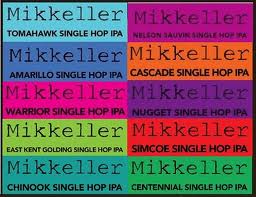 I have mentioned before (like here and here, for example) that I am a big fan of the whole “single hop” thing – where a beer is brewed with only one variety of hop for all additions. I have come to appreciate the educational opportunities of isolating the flavour and aroma characteristics of a particular hop variety. Particularly fun are when you can sample different single hop beer side-by-side. Earlier in the spring I did exactly that with the latest round of Mikkeller Single Hop IPAs available in Alberta. There happened to be 6 versions available at the same time (Tomahawk, Amarillo, Simcoe, Citra, Sorachi Ace and Nelson Sauvin). The base beer for the series is not the best IPA in the world, but it gets the job done. Besides the hops take all the arias in the show anyway.
I have mentioned before (like here and here, for example) that I am a big fan of the whole “single hop” thing – where a beer is brewed with only one variety of hop for all additions. I have come to appreciate the educational opportunities of isolating the flavour and aroma characteristics of a particular hop variety. Particularly fun are when you can sample different single hop beer side-by-side. Earlier in the spring I did exactly that with the latest round of Mikkeller Single Hop IPAs available in Alberta. There happened to be 6 versions available at the same time (Tomahawk, Amarillo, Simcoe, Citra, Sorachi Ace and Nelson Sauvin). The base beer for the series is not the best IPA in the world, but it gets the job done. Besides the hops take all the arias in the show anyway.
I laid them all six out side-by-side and tried them in succession (carefully ensuring I only had SOME of each bottle to keep my senses alert). I have had many experiences of hops altering the impression of a beer, but I was not prepared for what I experienced here. The only aspect that remained stable was colour. Virtually everything else changed. And the range was impressive – from traditional citrus and pine to lemon to (I swear!) Kool-Aid Tropical Punch. Body felt thinner or fuller, depending on the hops, and some even tasted sweeter than others. I can safely use the word “transformed” when describing what the hops did to each beer.
I wrote up the results of this taste experience, and the article is in the current issue of Planet S.
I strongly encourage anyone to try the side-by-side tasting. It draws out the differences so much clearer than simply taking notes and going from memory. To be sure, it is an activity best performed in the company of others, but you won’t be disappointed either way.
Plus, it will sharpen your palate and “hop chops”. You WILL have a stronger sense of exactly what each hop variety contributes to a beer, and you will get better at isolating those characters, even in a regular multi-hopped beer. That is not just beneficial for homebrewers but beer appreciators of all stripes.
And you will come away with a new kind of respect for the humble humulus lupulus. I know I have.

June 29, 2012 at 12:24 AM
We tried this experiment almost immediately after they first hit the shelves, and I even cheated a little bit because I still had a couple bottles of the more aged East Kent Golding version. It was a cool experiment, and it especially gave me an appreciation for Simcoe.
Being a homebrewer who doesn’t like to brew the same recipe twice, I’ve been doing this experiment myself, with the same recipe of a Double IPA, but my batches are usually at least a couple weeks apart in the brewing, and only a couple different hop varieties per summer before I move back to stouts, barleywines, and crazy concoctions. So having this many to try side by side was a fun opportunity. It’s amazing how different the beers can be just by changing the hop and nothing else.
I would love to see a brewer as experimental as Mikkeller try next is the same beer with different yeast strains…
June 29, 2012 at 11:00 PM
Nice graphic Jason. Yes, there were 19 versions made (or more?), plus a checkpoint IPA after the 10th and 19th. Next shipment arrives in a few weeks and will have the Centennial, Cascade, and Amarillo IPA series.
The malts used each time are the same: Pilsner, Cara-Crystal, Munich
Ernie, a yeast series was done last year or so ago with 6 yeast strains. If made again I will try to bring some in and/or there is rumors of a second series in the works.